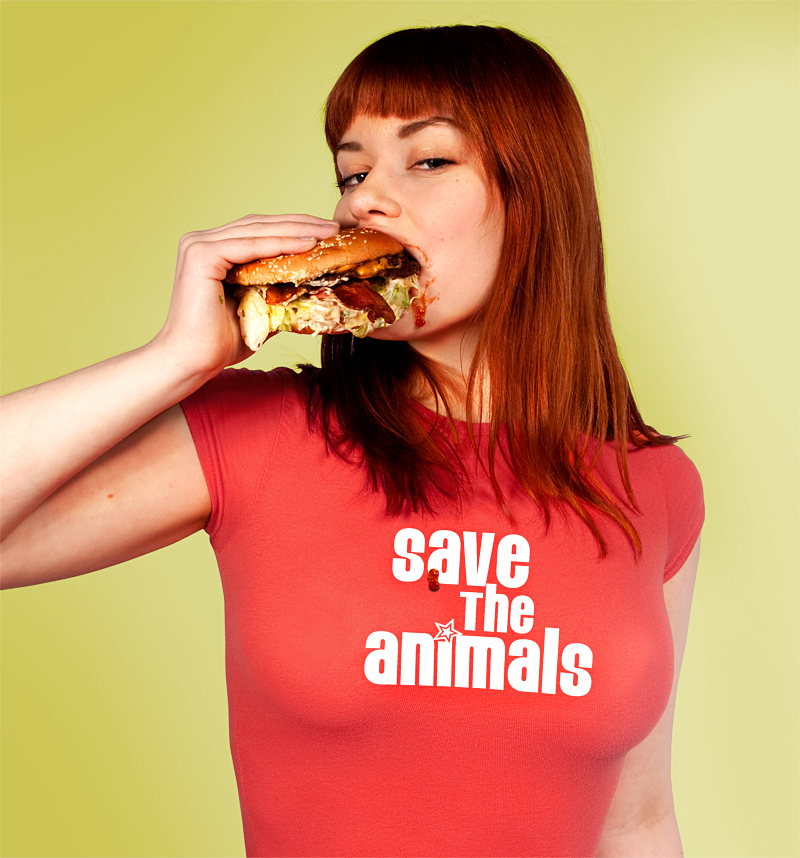The seed of the idea for Earth Day, which celebrates its 41st anniversary this Friday, was planted in Seattle on September 20, 1969. That’s when Wisconsin Senator Gaylord Nelson, fresh off of a harrowing tour of an oil spill off the coast of California, spoke to a fledgling conservation group at the University of Washington about the possibility of an environmental teach-in, analogous to the events being held at the time to support the civil-rights movement and protest the Vietnam War.
“Fledgling conservation group” are Wikipedia’s words. In truth, the only people who know how big or small the talk was—some insist it was a formal speech; others say Sen. Nelson was just shootin’ the shit—are all dead. But what matters today is that everyone, everywhere, thanks in part to Sen. Nelson, has some reason to feel guilty about the environment from the moment they wake up in the morning. And nowhere is that shared neurosis felt more profoundly than in Seattle.
Besides birthing the holiday, our city also had one of the country’s first curbside recycling programs. City Light was promoting energy efficiency in a time—the early ’70s—well before dropping those words might get you laid at a green-jobs happy hour. And prior to allowing a Sierra Club lawyer (more on him later) to steer Seattle with both green thumbs wrapped around the wheel, we had Greg Nickels, the man who jabbed his finger in the eye of the Bush (Jr.) administration by getting 300 other mayors to ratify the Kyoto Protocol when the President wouldn’t.
We are, by some measures, the greenest city in America. Which only means that when we fall, we fall harder. In identifying some classic cases of ecohypocrisy—instances when someone says one thing then does another, and whose contradiction contributes to our mutually assured environmental destruction—Seattle Weekly talked to some of the area’s most prominent environmentalists. All agreed that, when it comes to ecohypocrisy, there are often more shades of gray (or green) than in most issues. As one environmental leader put it, “One person’s advocate is another’s hypocrite,” and creating a more sustainable world is like “trying to fly a plane and redesign it at the same time.”
Digging for the Truth
At this point, nearly everyone we spoke to is suffering from tunnel fatigue. Some environmentalists claim replacing the Alaskan Way Viaduct with the world’s widest underground highway is the area’s biggest blind spot: the place where our values and actions most jarringly diverge. Others just want to “get the damn thing built already.”
But some say that, by opposing construction of the tunnel, Mayor Mike McGinn is actually violating his own green principles. If you want to preserve green space and promote density, two things McGinn approves of, there’s no better option than pushing heavy rush-hour traffic deep underground.
“The greenest option is the tunnel,” says one environmentalist who feared retribution if named. “Those cars will have to go somewhere. Having emissions and stormwater runoff underground is actually the best option.”
Call it the Richard Conlin argument. Last July, in an interview with the local bike blog Bike Intelligencer, the city council president said the same thing. “Creating an underground corridor takes your traffic away from the waterfront and keeps it going through the city while you create an urban waterfront center that you’re looking for,” said Conlin. “I see that as good management strategy.”
The mayor disagrees, dispatching a series of environmental vassals to explain why there is nothing green about the tunnel. Those charges—Eric de Place from Sightline, a carbon-emissions-focused think tank; Roger Valdez, most recently of Sightline; and Mike O’Brien, the only city councilmember to vote against the tunnel—instead offer a new ecohypocrite to be tarred and feathered: Gov. Christine Gregoire, whom Valdez points out signed a law to decrease the annual per capita vehicle miles traveled by 50 percent by 2050.
“This is so politicized,” O’Brien says of the tunnel fight. “The folks in the environmental community that I have always had a ton of respect for, that have asked the really hard questions, the ones that are on the table with the governor, have all told me behind the scenes that this is just awful. I was in the room with one of them [former King County executive and surface/transit option supporter], Ron Sims, a couple days before they announced the tunnel. I told him it’s too late to be making this kind of mistake, and Ron said, ‘I know, but I’m with her.’ “
Terry Brown, a spokesperson at the U.S. Department of Housing and Urban Development where Sims is now deputy secretary, said that Sims “recalls plenty of conversations with O’Brien, but none about the tunnel.”
Not Evergreen Enough
Like many forward-thinking academic institutions, The Evergreen State College has set a goal to become completely carbon-neutral. To do that, however, the school will have to ditch its primary source of heat and electricity: a natural-gas boiler that produces about 4,500 tons of carbon emissions each year.
The college’s Sustainability Council thought it’d found the solution: a “gasification chamber” fueled by wood chips left over from local logging operations. But a group of concerned citizens has succeeded in derailing the project by claiming it was not quite green enough for Evergreen.
Scott Morgan, sustainability coordinator at Evergreen, says the college first proposed the gasification project about a year ago. He says that finding an affordable and environmentally friendly energy source in southwest Washington—especially one capable of powering more than a million square feet of Evergreen’s Olympia campus—was a challenge, which is why they got the idea to use the region’s most plentiful resource, timber.
“Nothing else is available here,” says Morgan. “The only other options locally are [geothermal] heat pumps, and they’re about twice as expensive as the gasification. And we are in the middle of one of the largest timber-producing regions in the state.”
Gasification plants—also known as wood gas generators—are fueled by wood chips, usually produced from the “slash piles” left over from commercial logging. When a company like Weyerhaeuser harvests trees from a stretch of land, they leave behind gnarled messes of limbs, stumps, and debris. These leftovers are so cheap—selling for about $25 per ton, usually to make wood pulp—that they are often burned in the middle of the forest.
A gasification chamber takes the wood chips and heats them in two separate chambers, pumping oxygen into one and out of the other. The flammable gases produced burn relatively clean, especially compared to traditional combustion furnaces.
Several schools, including the University of British Columbia and Middlebury College and Green Mountain College in Vermont, have recently turned to gasification. Auburn University even has a mobile gasification chamber built onto the back of a semi that can be used to provide emergency electricity for disaster-stricken areas. But in the greater Olympia area and on the Evergreen campus, gasification was met with skepticism and outright hostility. Detractors, led by the group Concerned Citizens of Thurston County, claimed that a gasification chamber would actually increase carbon emissions, and, since operating one requires about 14,000 tons of wood chips annually, ultimately contribute to deforestation. Others complained that the $14 million price tag to convert the campus’ natural-gas building was too costly, especially at a time when the state’s higher-learning institutions are strapped for cash.
Local officials ultimately bowed to public pressure and instituted a one-year moratorium on biomass energy projects. Last month, Evergreen officials withdrew their request for a $3.7 million grant to help pay for a new heating and electric system, and announced they would no longer seek funding from the state for the project. (A separate, privately funded project, a $250 million commercial power plant that would have burned more than 600,000 tons of wood debris each year, was also scrapped in mid-March.)
In a letter to the school’s staff and faculty, Steve Trotter, chairman of Evergreen’s Sustainability Council, said the moratorium played a part in abandoning the plan, writing that it “leaves the status of future codes and permitting related to biomass too uncertain to pursue the project.” Morgan, meanwhile, says the controversy that derailed the gasification project was the result of misinformation and resistance from Evergreen’s hardcore save-the-forest types.
“We knew it would be a difficult sell here on campus,” he says. “Evergreen identifies with the forest a lot. A lot of people on campus see themselves as forest protectors, and do not support logging at all. We opened it up for study, but we got a lot of people who said ‘It’s already decided, this is bad.’ “
Morgan points out that they planned to source their slash fuel only from forests certified by the Forest Stewardship Council (see “Clear-Cutting Corners,” below), which ensures that the trees are grown, harvested, and manufactured in a sustainable way. He acknowledges that the gasification plant would actually increase direct carbon emissions from the campus—producing about 10,000 tons of greenhouse gases per year instead of 4,500 from the natural-gas operation—but says it’s actually more ecologically friendly from the big-picture perspective.
“If you just look at what’s coming out of the stack, you say ‘Wow, that’s terrible,'” Morgan says. “What they don’t want to count, and what a lot of people don’t recognize, is that the slash left out in the forest to decompose—not even the stuff being burned, but just sitting on the ground—will emit something like 3,000 metric tons of CO2-equivalent greenhouse gases. If you start looking at what we avoid emitting by transferring emissions from the forest to the plant, it does come out as a net benefit.”
Morgan says it’s now back to the drawing board to meet the school’s carbon-neutral goal. He says they’ll likely continue to use natural gas, a fuel that burns cleanly but damages the environment in Wyoming and British Columbia, where companies drill into the ground to obtain it.
“We’re going to have to find a compromise eventually,” he says. “Right now it seems like we don’t want this effect in our own backyard; we want it in somebody else’s backyard.”
Clear-Cutting Corners
Shortly after they moved into the White House, the Obamas decided to buy their two girls, Sasha and Malia, a swing set. On the set were the letters SFI, which stand for Sustainable Forestry Initiative. On the press release marking the purchase of the swing set (if you’ve ever wondered if anything can happen in Washington, D.C., without the simultaneous release of a statement marking the occasion, let this prove to you that it cannot) were the letters FSC, standing for the Forest Stewardship Council.
Being an eco-conscious consumer in 2011 means always being confused. And the lesson of the Obamas’ swing set is instructive, because it shows that behind that confusion lays the insidious corporate strategy known as greenwashing.
Both the FSC and the SFI purport to judge whether a wood product can be deemed environmentally friendly. (As one advocate put it, think of them as battling for the right to be the Good Housekeeping Seal of Approval, only for forests.) Both feature green-tree logos on their websites, got their start in the mid-’90s, and are nonprofits that play up the independent nature of their environmental assessments. But only one of the two groups is funded primarily by the same timber industry it’s supposed to be evaluating.
According to a report released last year by ForestEthics, a group devoted to protecting endangered woods, SFI has the admissions standards of a diploma mill. Of 543 audits of SFI-certified companies since 2004, the report found that only one lumber-cutter was denied the group’s eco-label. The reason: The company had, among other minor “violations,” failed to join the timber industry’s largest trade association.
SFI claims it has a well-rounded, environmentally friendly Board of Directors. Yet, at the time of the report, two of its members representing “the environmental sector” looked like anything but friends of the Earth. Michael Zagata, a former oil-company executive who still sits on the board as a representative of the Ruffled Grouse Society, was once New York Governor George Pataki’s Commissioner of Environmental Conservation. But he resigned after only 22 months, following what The New York Times described as “a series of actions favoring industry over the environment.” Former SFI board chairman Marvin Brown had a similarly embarrassing end to his tenure as Oregon State Forester, a job he left after his department was accused of tolerating violations of the Clean Water and Endangered Species Acts. (Also on the board: the CEOs of Weyerhaeuser, headquartered in Federal Way, and Plum Creek Timber Company, based in downtown Seattle.)
On top of all that, the report also found that SFI doesn’t require chain-of-custody tracking, meaning it doesn’t actually know where half of its wood comes from—which makes it hard to determine whether that fresh pine was cut in a sustainably grown forest or out of someone’s backyard—and lets companies stay certified even when they violate its extremely lax regulations.
So why is any of this important? Because being green in 2011 means big business. Half-a-trillion dollars’ worth, if you believe the high end of the estimates. And SFI’s ability to confuse the marketplace by adding another acronym to the mix doesn’t do anyone any good, especially the forests. After all, if the First Family can get tricked, what hope do the rest of us have?
Doublespeak Dave
Call it cynicism. Call it politics as usual. But whatever you call it, don’t forget that the leaked audio of Rep. Dave Reichert disinheriting the environmental votes he still touts as political accomplishments is a classic case of ecohypocrisy.
Reichert thought he was among friends last May when he gave a speech during a meeting of Republican precinct-committee officers at Orting High School. In a secret cell-phone recording eventually leaked to the media, he even went so far as to ask “Are there any reporters in the room?” and “All of us here are family, right?” before explaining to his political foot soldiers why, despite all evidence to the contrary, the former King County Sheriff first elected to Congress in 2004 was actually an EINO—Environmentalist in Name Only.
“If you want to hold on to this district,” Reichert told the crowd, “there are certain things that you must do.”
What are those things? For Reichert, it meant disowning the Wild Sky Wilderness, a piece of legislation—that he co-sponsored—which protected more than 100,000 acres in the Western Cascades, the first federally designated wilderness created in Washington since 1984.
At the 2007 announcement to introduce the Wild Sky legislation, Reichert sounded honored to have the opportunity to preserve such a pristine landscape. “I am so pleased to be working with a bipartisan, collaborative coalition so dedicated to this conservation effort,” he said.
Among his “family,” however, Reichert portrayed his sponsorship of Wild Sky as a shrewd maneuver meant to discourage environmental groups from donating millions to any challengers. The legislation was a “done deal,” he said, long before he ever got to it. “This is a 50/50 district,” said Reichert, referring to the moderate Eighth he represents. “There are certain moves, chess pieces, strategies I have to employ.”
Of course, once the audio became public, Reichert insisted that he played the game with his heart, not his head. “All you have to do is look at my voting record,” he told The Seattle Times. “I have been a staunch supporter of protecting the environment.”
Coal Comfort
Washington, like most states, has a complicated relationship with coal. Last month, a deal that had been in the works for years finally went through when Gov. Gregoire and TransAlta, the Alberta-based operator of a plant in Centralia that is the state’s largest emitter of greenhouse gases, agreed to shut down the company’s 470-foot smokestacks and convert to natural gas by 2025.
The agreement was a huge win for environmentalists. “This is a giant step forward in the move to cleaner energy,” said state Sen. Phil Rockefeller of Bainbridge Island. And as a result, Washington has now become one of the first states—after Oregon, of course—to put itself on the path to being coal-free. Yet at the same time, politicians like Gregoire—and one former environmental bigwig—are heralding the construction of ports that would ship hundreds of millions of tons of black gold across the Pacific.
China is devouring coal at a rate that can’t be satisfied by its own supply. The Rocky Mountains have what it needs. Washington sits between the two. And therein lies the problem.
Gregoire’s aides have already said that the governor doesn’t see the contradiction. “The issues aren’t linked in the governor’s mind,” one told The Seattle Times. “I do know that some people see it as exporting U.S. coal to China so they can burn it and bake the planet. But other people see it as a source of port jobs.”
And others see it still differently. “I think anybody who is reconciling themselves to coal export on the grounds that we’re not really responsible is playing ‘See no evil,’ ” says one environmentalist who asked not to be named for fear of pissing off the coal port’s powerful proponents.
So why go along with a deal that would make us accomplices in the back-alley beat-down of the ozone layer? For Gregoire, the answer seems to be that it will create a few dozen new jobs. For others, it’s about something else entirely.
“[The coal companies] have been trolling up and down the coast winning friends with bags of money,” says the anonymous environmentalist—friends that include Bruce Gryniewski, partner at Seattle PR firm Gallatin Public Affairs and former executive director of Washington Conservation Voters (WCV), who counts among his clients Millennium Bulk Terminals, a subsidiary of an Australian energy behemoth currently trying to build on the Columbia River.
“To go from being [head of WCV] to frontman for a bunch of coal companies to screw Washington to feed China is just pathetic,” says one local green exec furious at the perceived turnabout. “It’s a very long, hard fall. And environmentally there’s no excuse.”
Gryniewski declined to comment.
Spinoff
In the decidedly unsexy world of environmental reporting, “stormwater” just might be the unsexiest term of all. It is the second Belushi, third Kardashian, and fourth Baldwin all wrapped up into one unfortunate D-lister. Yet when it comes to the health of Puget Sound, stormwater is a star.
Nothing does more damage. The pollutants rain gathers while trickling to its final destination are going to cause problems somewhere. That somewhere is Puget Sound. One month ago, in an historic act of public consensus, members representing both environmental and business interests gathered on a stage in Olympia and, for the first time, essentially said as much: Stormwater was the bogeyman they all needed to help shove back under the bed.
But that’s where the agreements ended.
For the past three years, the Association of Washington Businesses (AWB), in conjunction with the powerful oil lobby, has successfully killed the Clean Water Jobs Act, the best possible defense against the damages wrought by runoff. The act would enforce a simple polluters’ tax: a 1 percent fee on the sale of all products featuring petroleum, by volume far and away the most prevalent toxic chemical present in stormwater. The AWB wouldn’t seem like a usual candidate for ecohypocrisy. And its stated reasons for opposing the bill—that singling out one industry to tax is a potential job-killer—falls in line with its philosophy. But all that’s changed now that AWB has simultaneously acknowledged the stormwater issue—onstage in Olympia, government-affairs director Grant Nelson agreed with his fellow panelists that “We’re all a part of the problem”—while opposing its most reasonable solution.
“I wouldn’t get down on AWB normally, because they always oppose everything,” says one green lobbyist upset at its role in killing the legislation. “But in the past six months, they’ve been so public about the stormwater issue, it’s kind of breathtaking to see them speak out of both sides of their mouth.”
The irony of the AWB’s opposition is that the Act it helped kill would actually do more to benefit business than hurt it. Washington’s current plan for stormwater infrastructure is built on the sweat of people who own land. Average Joes, business owners, and anyone else who pays a utility bill contributes to the construction of drainage projects that help keep the Sound from shimmering like oil-slick puddles in front of a Jiffy Lube. Unfortunately, that revenue pool, like all others during The Great Recession, is drying up. The AWB’s answer to this dilemma? Rather than tax the people responsible for the pollution, it would prefer that Washington siphon off a portion of the money that goes toward the state’s hazardous-waste-cleanup program.
Of course, in the wake of the nuclear panic in Japan, legislators, fearing a similar Armageddon on this side of the Pacific, are unlikely to dip into a rainy-day fund designed to clean up environmental disasters. Which means the ultimate result of the AWB’s inflexibility is that local and state governments will have to raise utility rates for business owners in order to maintain the status quo—the same business owners whom the AWB purports to represent.
Then there’s the missed opportunity that came with the death of the Clean Water Jobs Act’s 1 percent tax, which would have raised more than $100 million per year. It was heartily endorsed by labor, in part because that cash would have meant a lot of concrete poured and a lot of pipe laid in an effort to build more green infrastructure. In other words: more jobs, the one resource even scarcer than new revenue.
Carbon Bigfootprint
There’s nothing green about big summer music festivals. Transporting hundreds of thousands of people from one place to another—along with the infrastructure required to feed and bathe them and properly deal with their waste—is an act of environmental overkill, like pouring diesel on a campfire.
The people behind Sasquatch!, however, would have you believe that they’re different. And in some ways they are. Since 2007, the indie-rock festival held at the Gorge over Memorial Day weekend has aimed for carbon neutrality, investing enough money in renewable energy sources to offset the pollution it causes—money that, for Sasquatch! in years past, has gone to Pacific Northwest cattle farms that convert animal waste into electricity.
Carbon neutrality is an admirable goal. But it’s more a PR tool than anything else. It’s not that Sasquatch! is doing anything more to hurt the environment, but merely by buying carbon credits it’s not doing anything to reduce emissions. It’s as if, instead of robbing the rich to give to the poor, Robin Hood just stole five bucks from one destitute family, gave it to another that was equally impoverished, and then called it even.
There is of course a way to make Sasquatch! much better for the environment. But last May, festival organizer Adam Zacks told Seattle Weekly that his green goals wouldn’t be better served by moving the concert from a scenic vista 150 miles from civilization to Seattle Center, which people can actually reach by foot, bike, or bus.
“The environmental impact of driving to a remote area of the state is a con that gets drowned in a tsunami of pros,” said Zacks. “Ultimately I feel the uniqueness of the site is worth it, and it’s better to put our energies into minimizing the impact through education, offsets, alternative energy, improved recycling, and car-pool programs.”
Zacks and his team are clearly trying. And last year, part of minimizing that impact included bringing in a carbon-neutrality expert to streamline the festival’s approach to eco-equanimity. Of course, that might have been perceived as more than just a well-intentioned gesture if said expert had been local, rather than flown in from New York City.








